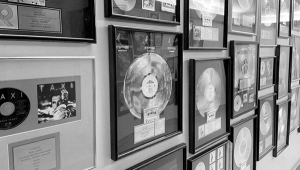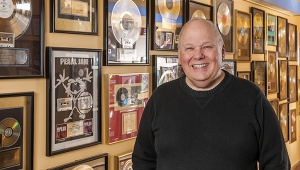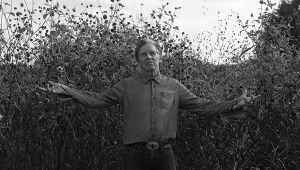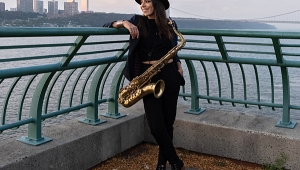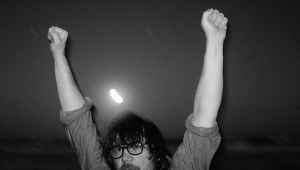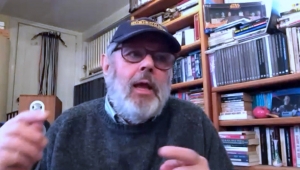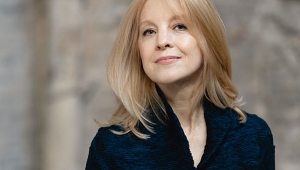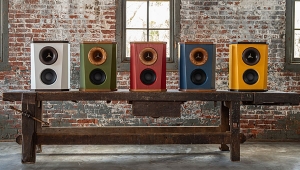| Columns Retired Columns & Blogs |
Poem: Stereophile Cuts an LP Page 2
And so, a $36 cab ride later, it turned out be. The Hancock Auditorium is an anonymous-looking building off the University of Southern California's main drag, hiding behind what appeared to be rhododendron trees. Capable of seating around 500, with seats gently sloping up to the rear, its stage featured a New York Steinway, flanked by a harpsichord and a Bösendorfer fitted with a computerized reproducing mechanism. Dominating the scene in front of the first row of seats, however, was an aluminum tower, similar to those used to support lighting rigs, wrapped in foam rubber and supporting two of the strangest-looking microphones I had ever laid eyes on. Each featured a conventional capsule/body assembly, apparently cannibalized from a Milab DC96B dual-rectangular diaphragm condenser mic, emerging from a hefty aluminum cylinder, and the pair were mounted one atop the other, capsules touching and angled at 90 degrees, with elaborate shockproofing. A long run of 7-conductor Cardas cable emerged from the base of each mic, connecting them to their own dedicated power supplies, in turn connected with AudioQuest interconnect to an EAR 824M tube microphone preamplifier. Further AudioQuest interconnect then disappeared out of a door at the back of the hall.
Back in the vestibule was a motley collection of tube electronics and a clunky-looking Ampex MR70 tape recorder. (A stamp on the first page of the Ampex's manual proclaimed that it had been purchased new by Elektra Records in 1969.) But of Kavi and the musicians, there was no sign.
 Unperturbed, at least sure that we had found the right place, RL and I set up the monitoring arrangements. Kavi was using Stax SRX headphones, I was listening through Stax Lambda Pros (both powered from the Lambda Professional power supply), while RL was using Sennheiser HD420SLs. All the headphones were fed from the Ampex MR70's monitor output so that we could listen to the off-tape signal. In addition, we set up a Sony WM-D3 Professional Walkman, purchased the previous day at Mills Recording Systems in Chicago, to make a cassette record of all of the takes for RL and me to listen to at our leisure. (We didn't want to play back the master tapes any more than we had to.)
Unperturbed, at least sure that we had found the right place, RL and I set up the monitoring arrangements. Kavi was using Stax SRX headphones, I was listening through Stax Lambda Pros (both powered from the Lambda Professional power supply), while RL was using Sennheiser HD420SLs. All the headphones were fed from the Ampex MR70's monitor output so that we could listen to the off-tape signal. In addition, we set up a Sony WM-D3 Professional Walkman, purchased the previous day at Mills Recording Systems in Chicago, to make a cassette record of all of the takes for RL and me to listen to at our leisure. (We didn't want to play back the master tapes any more than we had to.)
Kavi returned from lunch at 1pm with the musicians, flutist Gary Woodward and pianist Brooks Smith, and one of Gary's flute students, Heather Lockwood, to turn the pages for Brooks. Introductions over, Gary turned to me with a look of concern on his face. What would be my policy over takes? Would I be content with movements taken as a whole, or did I prefer to proceed in a piecemeal manner, four-measure segment by four-measure segment? At my answer, "Long takes!," smiles broke out. Apparently Gary, at least, had had similar experiences to my own at the hands of heavy-handed producers: piecing together a large number of short takes to make a whole may result in a note-perfect rendition of the music, but it emasculates any sense of performance.
We worked out the logistics: lacking any kind of talkback arrangement, Gary would announce—"slate"—each take. They would only stop at a catastrophic musical breakdown or if some outside event intervened. The Steinway had been tuned and the tape machine aligned before our arrival; Kavi had already recorded test tones on the first reel of tape—12kHz, 6kHz, 1kHz, 400Hz, 100Hz, and 40Hz—so that the eventual cutting engineer would have a reference for response and balance; we could start for real, therefore. We would begin with the first movement of the Reinecke sonata and carry on till the end.
Gary and Brooks played the first movement, the microphones about 5' above the flute and about 10' back, then came back to listen to the playback. (This was from the archive cassette, Kavi insisting that open-reel tape needs to be left alone for at least 24 hours before being respooled for playback on the grounds that this reduces print-through.)
Hmmm. There were a number of small problems. Gary felt that he should change to his platinum flute rather than the silver one he had started with. The piano, while producing a gorgeous tone, was tending to dominate the musical partnership with its sheer power. In addition, the balance between the direct sound of the instruments and the hall's reverberant field favored the piano slightly. All agreed, however, that the combination of Tim de Paravicini's tube microphones/preamp combo and the tube Ampex recorder was remarkably true to the instruments' tonal qualities. And despite the lack of any kind of noise reduction, the background was extremely quiet, what hiss there was being due to the mics themselves rather than to the tape.
We settled on reducing the piano's output by supporting the lid on the small stick rather than on the usual long one, and added a little more ambience by moving the microphones back by 6". Crossed, coincident figure-eight microphones, with their rear-facing response lobes, are amazingly sensitive to small differences in position: 12" further back captured far too much hall compared with the sound heard live. Another take indicated that the piano sound was now slightly boxy, something confirmed by listening to Brooks play live, so Richard and I moved the Steinway 9" or so further away from the rear wall of the stage, which proved to be sufficient.
- Log in or register to post comments

